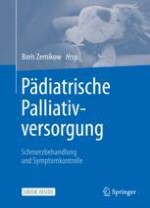Zusammenfassung
Bei onkologischen Patienten in der Palliativversorgung wird man regelhaft mit dem Vorliegen einer deutlich ausgeprägten Anämie konfrontiert. Die Versorger sind dann meist vor die Entscheidung gestellt, ob die Transfusion von Erythrozytenkonzentraten in der individuellen Situation des Patienten und unter Berücksichtigung des Versorgungssystems angemessen und sinnvoll ist.
Häufiger noch als eine Anämie tritt bei diesem Patientenkreis eine zum Teil ausgeprägte Thrombozytopenie auf. Besonders häufig sind dann Blutungen der Mund- und Nasenschleimhäute. Gravierende Blutungen hingegen kommen bei Kindern äußerst selten vor. Dennoch wirken auch bereits unbedenkliche Blutungen für den Patienten und die Eltern sehr bedrohlich. Die Begleiteffekte, der Geruch, die blutig gefärbte Wäsche oder Übelkeit durch altes verschlucktes Blut sind sehr leidvoll und belastend. Innere Blutungen, insbesondere ZNS – Blutungen, können lebensbedrohlich sein. Daher sind die Antizipation von Blutungskomplikationen und die Vorbereitung entsprechender Maßnahmen bei einer Blutung entscheidend. Behandlungsschemata, Abbildungen und Tabellen sind ebenso Bestandteile des Kapitels wie individuelle Fallbeispiele.











